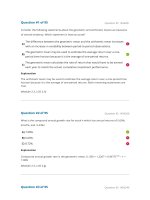Economic growth and economic development 78
Bạn đang xem bản rút gọn của tài liệu. Xem và tải ngay bản đầy đủ của tài liệu tại đây (138.07 KB, 1 trang )
Introduction to Modern Economic Growth
Proposition 2.5. Suppose that Assumptions 1 and 2 hold, then the steady-state
equilibrium of the Solow growth model described by the difference equation (2.16) is
globally asymptotically stable, and starting from any k (0) > 0, k (t) monotonically
converges to k ∗ .
Proof. Let g (k) ≡ sf (k) + (1 − δ) k. First observe that g 0 (k) exists and is
always strictly positive, i.e., g0 (k) > 0 for all k. Next, from (2.16), we have
(2.26)
k (t + 1) = g (k (t)) ,
with a unique steady state at k∗ . From (2.17), the steady-state capital k∗ satisfies
δk∗ = sf (k∗ ), or
(2.27)
k∗ = g (k ∗ ) .
Now recall that f (·) is concave and differentiable from Assumption 1 and satisfies
f (0) ≥ 0 from Assumption 2. For any strictly concave differentiable function, we
have
(2.28)
f (k) > f (0) + kf 0 (k) ≥ kf 0 (k) ,
where the second inequality uses the fact that f (0) ≥ 0. Since (2.28) implies that
δ = sf (k∗ ) /k ∗ > sf 0 (k∗ ), we have g 0 (k∗ ) = sf 0 (k∗ ) + 1 − δ < 1. Therefore,
g0 (k∗ ) ∈ (0, 1) .
Corollary 2.1 then establishes local asymptotic stability.
To prove global stability, note that for all k (t) ∈ (0, k ∗ ),
k (t + 1) − k∗ = g (k (t)) − g (k∗ )
Z k∗
= −
g0 (k) dk,
k(t)
< 0
where the first line follows by subtracting (2.27) from (2.26), the second line uses
the fundamental theorem of calculus, and the third line follows from the observation
64





